
Actually, it is not difficult for diabetic patients to cook, we are not talking about any specific diet. In type 1 and type 2 diabetes mellitus, an important role is played by a balanced diet, which is not only for a sick person. but also suitable for a healthy person.
No
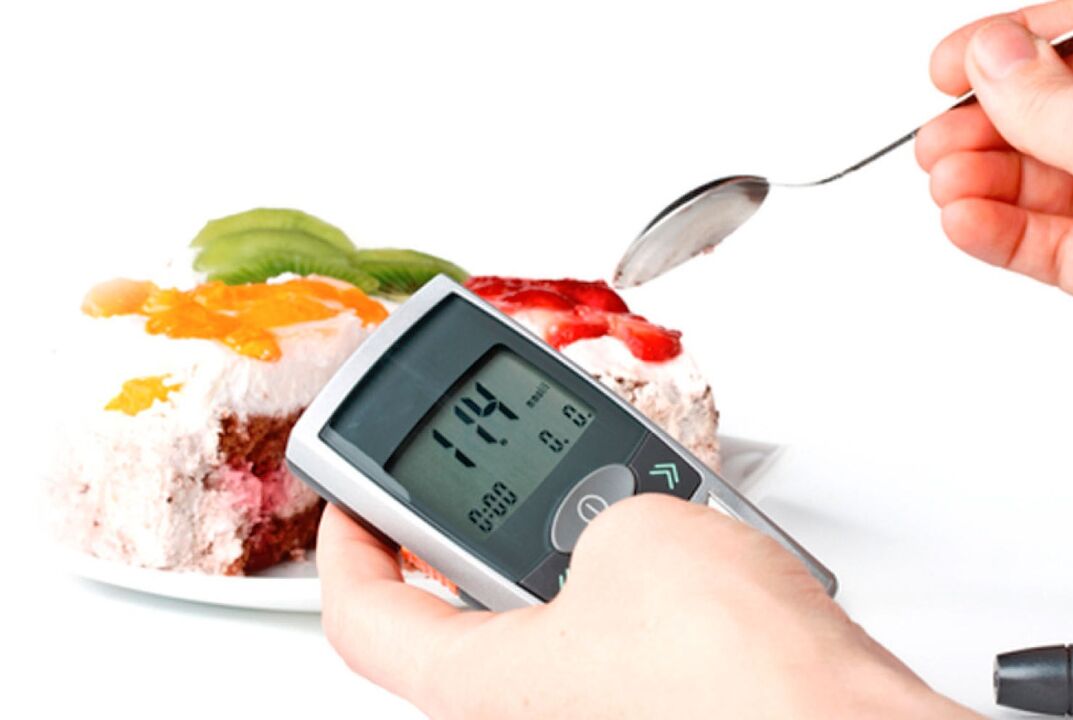
The first is the fact that diabetes mellitus nutrition involves limiting all direct sugars: dishes with diabetes mellitus (first, second courses and even desserts) are devoid of sugar or honey, sweet foods are excluded - cakes, Ice cream, desserts (apple pie, fruit pudding, pancakes, etc. ), cookies, sweets, cakes, chocolate, sugary drinks and juices, etc. , fatty and fried foods, fatty meats and sausages, beer, wine, white orBlack bread (usually with caramel added to it) and any product made from white flour.
In addition, dried fruits, grape wine, prunes and pears should be completely avoided. With regard to alcoholic beverages, exclude beer, drink only dry wine, up to 200 ml per day, strong alcoholic only as a last resortDrink the drink, and extremely pure. Remember to include alcohol in your daily caloric intake.
Yes
Eat only whole grain bread. Meat can be cooked, but especially lean!
Be careful with the side dishes, if you want to make dumplings or dumplings, do not forget to take into account the portion size. Rice, pasta, potatoes are more suitable.
For diabetics, recipes should include vegetables (which should also be eaten raw) because they contain vitamins, minerals, protein and contain almost no (or minimal) sugar. Among vegetables, you should include carrots, peas and corn. Needs to be limited. Fruits can be consumed at most once a day, best as a morning snack.
It is advisable to divide the meal into 4-6 small meals during the day, having a light snack in the evening. Recipes for diabetes mellitus and the amount of food should be selected on the basis that your body weight is within the normal rangeHave or need to reduce it, as well as how much you move during the day.
For all diabetics, walking for at least 30 minutes a day is appropriate and recommended; Brisk walking, running, swimming, cycling etc works well.
You need to take at least 10, 000 steps daily.
It is quite understandable that at times the diet plan will seem unbearable, and an irresistible urge to eat something from the "forbidden" will appear. Once a month, you can relax and indulge in dark chocolate (chocolate suitable for cookingor which contains 60-70% cocoa).
If you decide to change your eating habits, it is recommended that you first check with your doctor or specialist, such as a diabetologist, about subsequent adjustments in the dosage of diabetes medications and insulin. Self-monitoring using a glucometer is recommended.
Diet and regular measures are indispensable (neither treatment, nor insulin, etc. ), and represent the basis of successful treatment for all diabetics! These facts are confirmed by a large number of specialized scientific studies in our country and in the world.
diet for diabetes
Prohibited products:
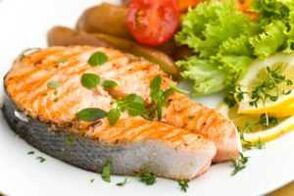
- Fatty dairy products.
- Yolks and their products.
- Sauce.
- Fatty meat - goose, duck.
- Concentrated alcohol.
- Free Sugar.
- Sweets.
- Salty snacks - chips, nuts, snacks etc.
Recommended products:
- Fats -- butter, margarine, milk and dairy products -- are all low in fat.
- Meat - young animals (veal, pork, lamb, chicken, rabbit, turkey).
- Fish - freshwater and marine.
- deer meat.
- Ham - in small quantities.
- Vegetables - all types, including legumes.
- Fruits - in moderation.
- Bread is whole wheat.
The technical methods that can be used are boiling, boiling, frying, rarely - frying.
Below are some diabetic recipes, from soups and main courses to desserts, that are suitable for diabetics.
The amount of raw materials in the following recipes for diabetes is designed for 4 servings.
Diet soup for diabetics
soybean soup
Component:
60 g soybean, 20 g flour, 20 g butter, 20 g onion, garlic, parsley, salt.
Preparation:
Soyabean should be boiled till cooked or canned. Add finely chopped onions to the butter, add refined flour and pour hot water. Bring to a boil, add boiled soybeans, chopped garlic salt and chopped parsley. Cooked soup is best consumed hot.
Diet staple food for diabetics
fried flounder
Component:
600 grams flounder, 20 grams butter, salt, capsicum, 10 grams wheat flour, 1 lemon.
Preparation:
Drizzle with oil and grill, adding salt and ground black pepper to wheat flour. Season the finished dish with lemon juice and garnish with lemon wedges.
goulash
Component:
320 g meat (beef, veal, pork, rabbit, but best of all - mixed), 200 g tomato, 40 g oil, 1 onion, 20 g potato, salt, parsley, marjoram, cumin.
Preparation:
Quickly fry the peeled meat cubes in oil and cover with hot water. Add salt, chopped tomatoes, peeled whole onions and boil. When the meat is almost tender, peeled, finely grated raw potatoes, gratedAdd cumin and marjoram. Remove the onion from the finished stew (if boiled, discard it) and add finely chopped parsley.
Diet vegetable dishes for diabetics
Stuffed Tomatoes
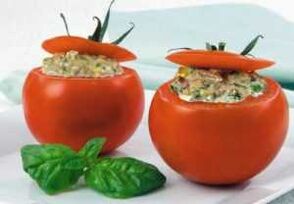
Component:
4 large hard tomatoes, 120 grams of poultry meat, 20 grams of rice, 20 grams of butter, 1 egg, salt.
Preparation:
Cut off the top of the washed tomatoes and remove from the middle. Boil the washed rice in salted water, mix with minced poultry meat, salt, add the beaten egg and mix well.
Fill the prepared tomatoes with the mixture from center to center, cover with chopped tops and keep in a lightly oiled container. Add hot water and cover and bring to a boil.
Boil the removed core, grind and pour into the prepared dish.
Vegetable Risotto
Component:
160 g rice, 20 g carrot, 20 g cauliflower, 15 g celery, 15 g parsley, 10 g corn, oil, parsley, salt, 120 g hard cheese.
Preparation:
Cut all peeled vegetables into cubes or grate on a coarse grater. Cut off the legs from the cauliflower, and divide the heads into small inflorescences. Wash the corn. Wash the rice, add oil, water, salt and bring to a boil. Let come. After a while, add the prepared vegetables and cook until soft. Serve the finished risotto, sprinkle with chopped parsley and grated cheese.
diet cold food for diabetics
cottage cheese with vegetables
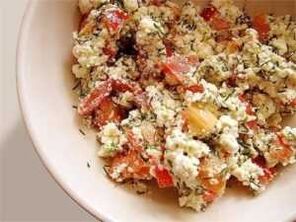
Component:
200 g cottage cheese, 40 g milk, 1 tomato, 20 g leek, 40 g cucumber, salt, ground cumin.
Preparation:
Peel the tomato, remove the seeds, peel the pulp and cut it into thin strips, grate the cucumber on a coarse grater.
Beat the salted cottage cheese with milk.
Add all the prepared vegetables to the resulting curd mass, and cumin to taste.
yogurt breakfast
Component:
200 grams of cottage cheese, 2 cloves of garlic, sesame, salt, green onions, dill, parsley.
Preparation:
Grind garlic with salt and mix with cottage cheese. Thin with water if necessary to make a dense mass. Finely chop green onions and add sesame seeds to it. Make a roll of cooked garlic-curd mass, green onionsAnd wrap in sesame mixture so that its surface is completely covered. Leave the prepared rolls to cool down to harden.
Diet Salads for Diabetics
Apple and Chicken Salad
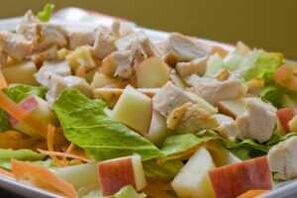
80 g carrot, 60 g bean sprouts, 200 g sour apple, 100 g cooked chicken breast, salt, 10 g butter, lemon juice.
Preparation:
Grate the peeled carrots on a coarse grater, wash the apples, remove the core from them, cut into slices, and then into thin strips like the finished chicken meat.
Mix all the prepared ingredients together, drizzle with bean sprouts, salt, oil and lemon juice. Stir well again and leave to cool.
Five myths about diabetes
Diabetes mellitus is a chronic, lifelong disease that is fraught with complications. Those who have had it, have to learn to live with it and adapt their rhythm and way of life to it. Widely discussed, there are still many myths surrounding this disease. Let's take a look at the main ones. So…
Myth: Diabetes is a disease in obese people.
People rarely recognize the difference between type 1 and type 2 diabetes. Type 1 diabetes can develop in childhood. The disease is genetically determined, requiring insulin therapy. In contrast, as noted aboveHowever, type 2 diabetes is often associated with being overweight. The disease is characterized by a slow onset.
Myth: Diabetes is an "old" disease.
As there are many obese children and youth today, type 2 diabetes is increasingly affecting younger age groups.
Myth: Diabetics should never eat sweets and follow a strict diet.

Of course, diet is important, but it is not about eliminating carbohydrates completely. Diabetics cannot eat simple sugars (glucose), beet sugar (sucrose) and honey. However, they can use artificial sweetenersA diabetic patient should eat complex carbohydrates (starches).
With diabetes mellitus, sweets can only be replaced by sweets - sweeteners, fruits. For example, you can eat two or three peaches, two oranges or three apples. Or you can eat something made of sweets.
Nutritionists recommend preparing sweets at home, this approach ensures that dishes are free of harmful preservatives and additives. From available and permitted products, you can prepare any dish, and enjoy a treat with yourself and your loved ones. Delicious sweet treat.
Myth: Diabetics can eat well, they just need to cut out sugar.
As mentioned, diabetes management involves regulating carbohydrate intake. The diet should contain the same amount of complex carbohydrates per day, as prescribed by the doctor. The prescribed amount should be distributed throughout the day, since diabetesThe patient should eat regularly. The principles of the diabetes diet are in line with the principles of balanced nutrition, so it is not only about regulating the sugar content, but also controlling the whole composition of the diet. The essence of the disease is not onlyInherited in metabolic disorders at the level of carbohydrates, but also proteins and fats.
Myth: Diabetics can eat as much fruit as they want.
Fruits contain a certain amount of carbohydrates. Obviously, it is their content that a diabetic patient should include in their daily diet. Thus, you cannot eat fruits in any quantity. It would have been better to choose those varieties. They contain minimal amounts of carbohydrates and are rich in fiber, which is important for digestion.














































































